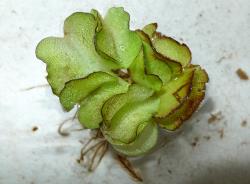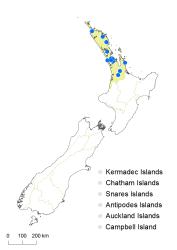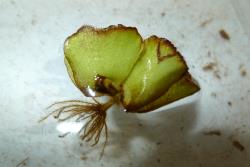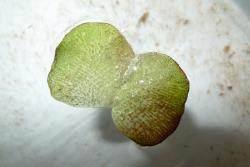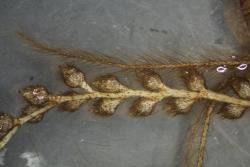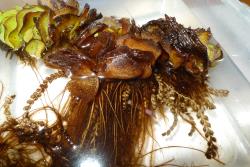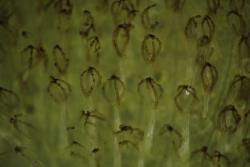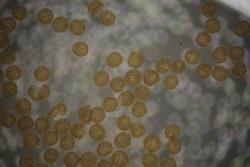- Taxon
- Weed
Aquatic fern, forming free-floating dense mats, with leaves tightly overlapping. Floating leaves broadly elliptic to orbicular when young, becoming broader than long at maturity, 12–30 mm long, 15–50 mm wide, often conduplicately folded along the midrib; apex emarginate; margins entire, sometimes inrolled; base cordate, shortly stalked; upper surface light or brownish-green, becoming darker on the margins, densely covered in papillae each bearing 2 or 4 uniseriate hairs united at their distal ends (shaped like an egg-whisk); papillae up to 3 mm long. Submerged leaves branched, 25–300 mm long, densely covered in brown septate hairs 1–3 mm long. Fertile axes on submerged leaves 15–70 mm long, bearing 4–20 pairs of sporocarps arranged in 2 rows. Sporocarps spheroidal or ovoid, 2–3 mm long, 1–2 mm wide, densely hairy, subsessile, containing sporangia that are usually empty or produce only aborted spores.
Salvinia ×molesta is easily recognised by its floating habit, its dimorphic leaves arranged in whorls of three, and the presence of egg-whisk-shaped hairs on the leaves for buoyancy. When mature and opened out, the floating leaves are shaped like the wings of a butterfly. The plant is sterile, with sporocarps containing only empty sporangia, or aborted spores, and is probably of hybrid origin.
North Island: Northland, Auckland.
Altitudinal range: 0–50 m.
A rampant weed of tropical and warm temperate regions, recorded as a naturalised plant in lowland areas of northern New Zealand from near Kaitaia to Hamilton. There are additional records of the plant from garden ponds as far east and south as Wairoa (AK 245013).
Recorded as an aquatic weed on lakes and ornamental ponds, and in Eleocharis sphacelata swamp.
Mason (1964, p. 235), Armiger (1964) – as Salvinia natans. Voucher: CHR 234901, 1961.
Salvinia ×molesta has been declared a noxious weed in New Zealand. It is believed to be a hybrid of horticultural origin from South America, now widely distributed in Africa and other areas outside the neotropics (Mitchell 1972). It is a pentaploid with 45 chromosomes (Schneller 1981).
It is very similar to S. biloba (syn. S. herzogii) from South America (de la Sota 1962, 1995; Tryon & Tryon 1982). At least some forms of this latter species are also probably of hybrid origin (Schneller 1990), and are distinguishable from S. ×molesta only by their chromosome number (Schneller 1980). However, there are no records of S. biloba in horticultural cultivation, and infestations outside South America all seem to be referable to S. ×molesta.
It has been proposed that the earlier name, S. adnata Desv., should replace S. ×molesta (de la Sota 1995). However, Moran & Smith (1999) argued that S. adnata is of uncertain application, possibly attributable to either S. biloba or S. ×molesta. Desvaux’s type specimen is vegetative, and although de la Sota (2001) provided some characters for distinguishing S. biloba and S. ×molesta, he was unable to examine them in the type specimen itself. The name S. ×molesta should therefore continue to be used for the invasive plant of the Old World tropics.



